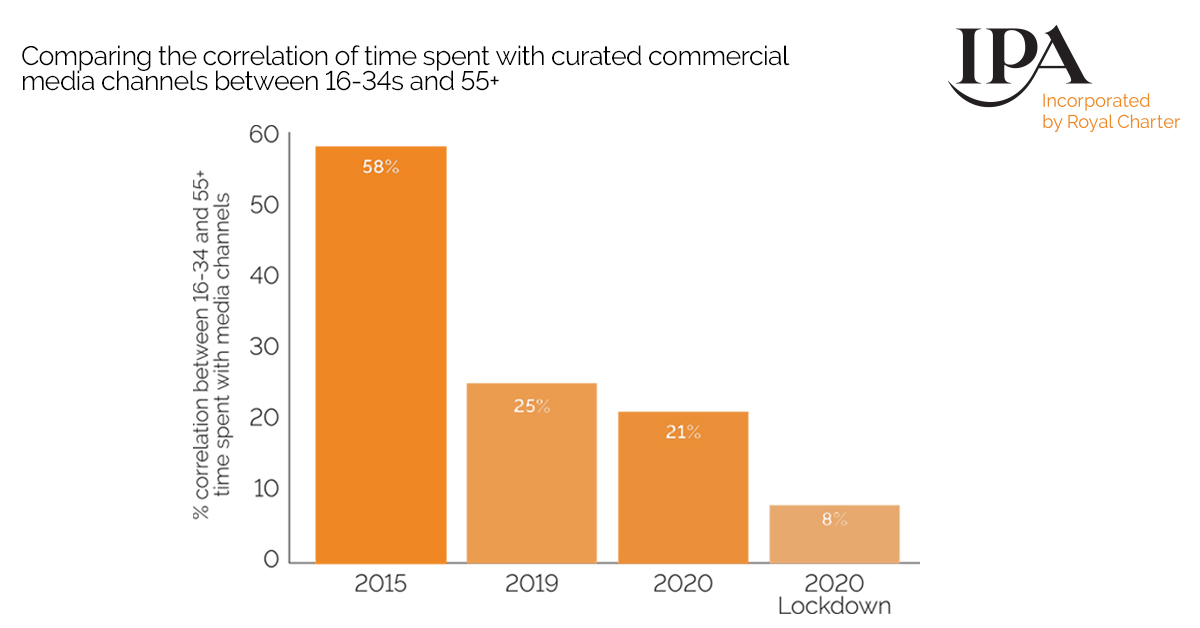How much did lockdown change the way we behave, and what are the long term implications for brand-building? Following the launch of our new IPA TouchPoints report, Making Sense, the IPA’s Simon Frazier explores what you need to know about commercial media in the 2020s.
The world has seen some astonishing changes over the last 12 months, changes which none of us could have ever predicted. National lockdowns forced significant and immediate shifts in our daily behaviour, accelerating some existing trends and completely upending others.
Our latest IPA TouchPoints report, Making Sense, charts the impact of the first 2020 lockdown on commercial media consumption and one of most striking findings is the significant drop in correlation between how 16-34 and 55+ spend their media time. We’ve gone from a 58% similarity between the media behaviours of 16-34 and 55+ in 2015 to just 8% in the March-June 2020 Lockdown. Staggeringly, 79% of commercial media time for 16-34s is now spent with digital media.

To put it simply, your lockdown experience has probably been completely different from that of your colleagues, family or neighbours.
The generational divergence in media habits is quite astonishing and reminds us that the last five years have, for some, seen more changes in media consumption than the previous 50, whilst for others (55+) the changes have been significantly slower. These changes have been driven by the rapid growth of smartphone usage and subscription-based media. However, the shifts are not universal; the commercial media landscape is becoming increasingly fragmented.

To stream or not to stream?
We know from the work of Binet and Field that video is key for brand building, but there are now more options than ever in terms of how to consume that video.
WandaVision may be the most popular TV show in the world right now, but despite the much talked about Streaming Wars and perceived rapid growth of subscription-based services such as Netflix, Prime Video and Disney+, the share of total media time which is not funded by advertising has only increased from 34% to 38% in the five years from 2015-2020.
Streaming is certainly growing, but traditional TV still has the ability to deliver substantial scale across all audiences. While Streaming has seen unquestionable growth in the last five years, the biggest shift in the video content space has been in Other Online Video (e.g. YouTube), which during lockdown commanded more time among 16-34s than Live/Recorded TV for the first time.
The lockdown anomaly?
In general, our media habits have changed very little over the past 15 years. The shape of a media day in 2005 vs. early 2020 shows that people are still watching video in the evening, audio is still peaking in the morning, OOH builds as the day progresses and tails off towards the evening, and reading text is at a comparatively lower but consistent level throughout the day.
The immense change caused by lockdown caused the first ever deviation from these established patterns. Text-based media grew across the day, the morning audio peak moved nearer to midday and we saw a large rise in the evening video peak.
As we hope for an end to the pandemic in 2021, the key question is whether these new behaviours hold-up, or are consigned to history. If flexible working becomes the norm, then we could see then the next few years could mark the biggest sustained changes to our behaviour for decades. Or, we could see our national love of banana bread become nothing more than a fleeting memory.
So what should brands do?
Our findings clearly show that the combination of both digital and non-digital media has the greatest potential for brand building today, and that traditionally opposed media platforms often work far better in harmony with each other than in competition. The media landscape has never been more crowded and complex than it is today, so this report looks to give clarity on where brands should focus their research, attention and effort to continue to thrive post COVID-19.
While our lives have changed dramatically in recent months, and we don’t yet know which new behaviours will become the new long-term norm, it’s important to remind ourselves that the roles of media and advertising are still about delivering: the right message to the right person at the right time and in the right context.
Simon Frazier is a Senior Research & Marketing Manager at the IPA. Making Sense: The Commercial Media Landscape (third edition) is available as a free digital download and flipbook, and the data is available as a free download in Excel format.
Download your copy of Making Sense: The Commercial Media Landscape


